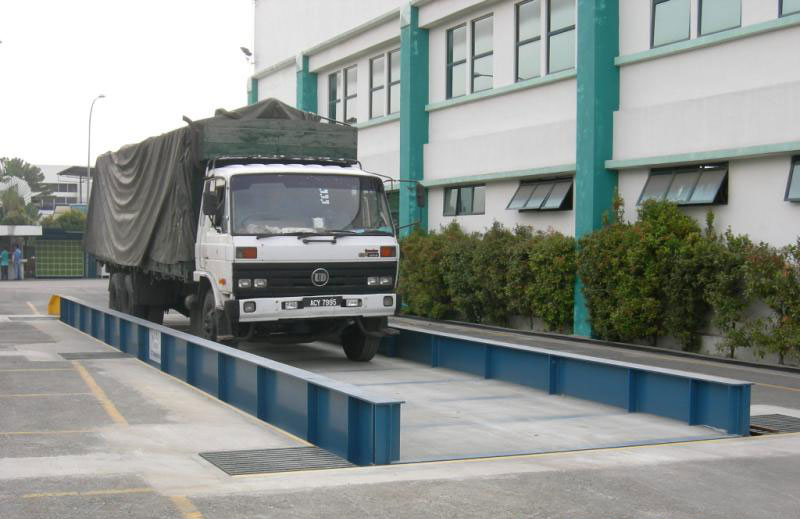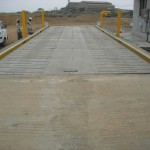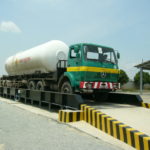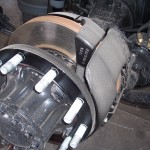
OTHER FACTORS THAT CAN AFFECT ACCURACY OF WEIGHBRIDGE
A credible weight system is essential for any industry using the measurement of weight as a benchmark for sale of a product. Understanding the factors affecting the accuracy of weighbridge systems is therefore considered vital if measurement errors are to be minimized. Whether weight, or volume calculated from a weight measure, is used as a basis for payment, the accuracy and integrity of a weighing system is critical to both the buyer and seller. If the weighbridge system records payload weights that are too high, the buyer will be paying for products that he/she is not receiving. If, however, the weighbridge is under weighing, the manufacturer will be missing out on potential revenue from constantly making up for differential that are not real.
SOURCES OF VARIATION
While platform weighbridges can be said to give the highest levels of accuracy for vehicle weights (compared with single axle weighbridges or portable wheel axle weighers) no weighbridge can ever be totally accurate all of the time. Sources of variation effecting gross, tare and stored-tare weights can be split into five main categories viz;
- Mechanical (to do with the weighbridge)
- Environmental
- Truck-related
- Human
- System related
MECHANICAL VARIATION
When weighbridges are being tested and legally stamped for approval it is recognized that they are comprised of mechanical and electronic components, which have inherent variability. The weights and measures law of various countries and states specify the maximum level of deviation in reading that is permitted from known test weights. For example, for vehicle loads in the US, the National Institute of Standards Handbook specifies an acceptance tolerance of 0.1% (e.g. +/-40 kg on a 40 ton load). It is important to note however, that weighbridges do drift out of calibration and that the same load may give different readings on different weighbridges.
ENVIRONMENTAL VARIATION
Most weighbridges in the manufacturing or mining industry are open to the environment. Environmental factors such as moisture and dirt, wind loading, shock loading, vibration and large temperature changes can produce errors in the load cell observation, thereby producing incorrect measurements.
a. Moisture and Dirt
If a weighbridge is not regularly maintained a buildup of dirt can affect the electronics, increase the wear on the metal components of the load cells, and physically stop the bridge settling as far as it should with a loaded weight.
For example, muds and dirt on quarry trucks can add 300 to 500 kg of extra weight depending on the truck configuration. A truck weighed on a wet day can weigh significantly more than if it was later re-weighed during a dry period.
Washing the truck and load before driving onto the weighbridge is one way of overcoming the problem of buildup of detritus on trucks. For example, some dairy companies require their milk tankers to be washed before weighing.
b. Wind
Weighbridge operators comment that wind blowing on the side of a truck can affect the readings, up or down even for an empty truck. If the wind is blowing horizontally the force caused by the wind is likely to cause a shift in the center of gravity of the load and a redistribution of weight onto the wheels on the leeward side of the truck – possibly resulting in a variation in weighbridge reading, depending on how evenly balanced are the load cells supporting the weighbridge. If, however, the wind is blowing at a downward angle onto the truck there will be both a redistribution of weight to the leeward side and an increase in overall “weight” measured by the weighbridge – caused by the downward force component of the wind. Locating the weighbridge inside an enclosure is one way of minimizing the effects of wind. Allowance should be made for the effects of wind pressure on the load
c. Temperature and Humidity
Temperature and humidity are known to affect the load cells used in weighbridges. Most modern weighing systems have temperature compensation systems, however. Provided the temperature range of these compensation systems exceeds the expected range of ambient and operating variations that the weighbridge is operating under there should be little effect on weighbridge readings.
d. Shock Loading and Vibration
Shock loading on weighing systems occurs when a heavy object is dumped onto a weighing system; the platform is bumped by a vehicle or is otherwise disturbed. Most load cells can withstand up to 200% of their capacity in side loads. If an extreme sudden loading is applied to a weighbridge the load cells should be checked and recalibrated.
Vibration from processing equipment and other sources such as the movement of other trucks near the weighbridge can cause the load cells to measure the weight of material as well as vibration that is transmitted to them. Vibration effects can be reduced by isolating the weighing system from vibration sources, where possible, or by using weighing system instrumentation that automatically removes vibration effects.
TRUCK RELATED VARIATION
Most trucks carry a range of “removable” equipment such as tire irons, chains and tool box and along with the spare tires and fuel these can have a substantial effect on the weight of the truck. For example, spare tyres weigh about 120 kg each.
Fuel has been identified as one of the major variables in truck weight. Depending on fuel tank capacity and level, fuel can account for a variation of up to 600 kg for some trucks.
If a stored-tare weight system is used it is important to record each time the truck is weighed whether the truck is carrying spare tires and what its fuel loading is.
Another variable, which can effect tare weight variation, is the truck configuration. If the truck is too long to fit onto the weighbridge it has to be weighed in several increments. If access to the bridge is not perfectly level, additional weight will be registered on each reading due to axle “shifts” and the shifts in the centers of gravity of the truck and trailer.
HUMAN VARIATION
Variation in weight readings caused by humans can fit into two categories; driver errors/fraud and bridge operator errors.
a. Driver “errors”
Since the weight of truck drivers could range somewhere between 70 kg and 120 kg, whether a driver is in or out of the cabin during the weighing process can cause variation in both the gross and tare weights. This problem is doubled if the truck is carrying a passenger; e.g, when the driver is showing a new driver the route.
Some companies had a written policy on whether the truck driver should be in or out of the truck when it is being weighed. Adhering to the “driver out during weighing” policy where practical or recording whether the driver is in or out is the best way to help reduce any variation that could be caused by the driver. Consistency in following the policy is also required.
Although not an error as such, another source of variation in weighbridge weights is the deliberate lightening of loads before a tare weight is taken. Most companies and countries would see this as fraud.
b. Bridge operator “errors”
Bridge operator error, although rare, can occur especially when the bridge is under high demand. The sorts of errors that have been occasionally observed are:
- the back axle was not correctly on the bridge
- when split weighing a load, an axle was reweighed when not properly off the bridge
- the wrong truck or trailer identification number was entered into the computer for the load that was being weighed; thereby leading to the wrong stored-tare weight for net payload calculations.
Some weighbridge systems automatically detect whether the truck is fully on the weighbridge or not, thereby minimizing the chances of the first two types of error occurring. Some weighbridge systems also automatically read an identity tag for the truck, thereby minimizing the chances of the third type of error occurring.
c. Unmanned Bridge “Errors”
Some weighbridges may be unmanned because of very low demand for their use. These unmanned bridges are operated by the truck driver who may, or may not, remember to zero the bridge scales before weighing the load. To save time and quickly determine the net load the drivers are also known to sometimes use the permanent tare weight recorded on the side of the truck. The accuracy and integrity of a weight system such as this is unknown but is unlikely to match that of the well-maintained and manned systems described earlier in this paper.
SYSTEM-RELATED VARIATION
In the Mechanical Variation section of this paper it was mentioned that the accuracy of weighbridges could drift with time. It is, therefore, important to monitor accuracy on a regular basis. Many countries regulate the frequency by which weighbridges have to be checked and stamped for approved usage. For example, both New Zealand and Australia require weighbridges to be “stamped” on an annual basis. As a comparison, Washington in the United States requires weighbridges to be stamped on a six-monthly basis. Weighbridge owners can, of course, monitor the accuracy of their weighbridges on a more frequent basis than is legally required and arrange for the weighbridges to be adjusted by qualified specialists if the weighbridges are not operating within acceptable tolerances.
For companies that check their weighbridges monthly or bi-monthly, the motivation could be that they wanted to minimize risk to themselves of long-term errors and be able to demonstrate to their customers the integrity of their weight measurement system.
CONCLUSION
The majority of the sources of variation can be minimized by designing and maintaining the weighbridge correctly and by following well designed procedures for the operating and checking of a weighbridge.
The weighbridge and its approaches should be designed so that water and debris do not accumulate on the platform(s).
Most countries that use weighbridges have minimum standards for operating weighbridges. Usually these standards are laid down in law. It is important to remember that these are just that – minimum standards. Particularly when it comes to checking that the weighbridges are operating within acceptable tolerances, high use industries, like the manufacturing industry, may benefit from exceeding these minimum standards.
It is important for gaining control of weighbridge accuracy to maintain and implement appropriate procedures for operating a weighbridge. These procedures need to cover what should, and should not, be included when a truck is weighed. The details of these procedures are not as important as the fact that they are always carried out. The procedures should, however, include details on whether the truck is weighed with or without the driver, the need for passengers to be out of the truck when weighing and the equipment that the truck should have.
The ideal situation for a goods-supply-by-weight system is to be able to tare-in and tare-out all trucks. By using the tare-in and tare-out approach major variation, caused by such factors as fuel and mud, can be minimized. This will help to minimize any systematic bias.
It is inappropriate to expect a weighing system such as a weighbridge to weigh 100% accurately 100% of the time. However, by keeping the possible sources of variation in mind when building and operating a weighbridge, inaccurate weighing can be kept to a minimum – whether a tare-in tare-out system or a stored-tare weight system is used.
As the use of weighbridges increases, an understanding of the accuracy and integrity of weighbridge systems grows in importance. Weighbridges, in comparison with some other mensuration and scaling activities, tend to be very accurate. The sources of error as earlier explained comprise mechanical, environmental, truck, human and system-related. Although it is difficult to put a figure on the possible magnitude of these errors, it is unlikely, however, that all sources of error will act in the same direction at the one time.
Almost all of the variation can however be minimized by; installing a well-designed bridge, regularly maintaining the bridge, following well designed procedures for operating an accurate weighbridge system and ‘keeping’ a constant lookout for compromised personnel.







